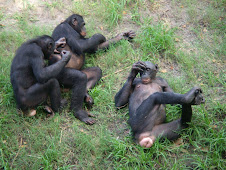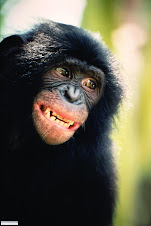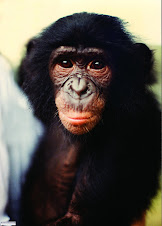
In 1991, After the French pulled out, the Assistant Director, Dr. Kankienza, was placed in charge of the INRB. Kankienza had a live and let live attitude and he allowed me to stay and work at the institute. With the change in the government under Kabila, Kankienza lost his post.
Two years after leaving the country, I went back in the year 2000 for a visit. I learned that Dr. Kankienza had been "rehabilitated" and was the director of a tuberculosis clinic. I took a taxi (an adventure in itself) and found him in his office. From
Grains of Golden Sand:"Kankienza sat behind an enormous desk piled high with papers. When he saw me, he leaped up and exclaimed, “I never expected to see you here!”
"While we made chit-chat, I noted his overflowing ashtray, an old topic of good-natured bantering between us. He boomed a laugh. “Remember I told you that my physician said to stop smoking or it was going to kill me? Guess who kicked the bucket? Ha! My doctor!”
“Look at me—the picture of health!” He grinned. “Now I’m told that I should lose a little weight. Personally,” he said “I think it is the same bum advice as for cigarettes!”
"Kankienza still had his cherub cheeks and beaming smile, but he seemed somewhat gaunt with a lot less chrome on the chassis than before. Now, with a regular salary, I imagined that his outline would creep back to its former corpulent contour.
“Hey,” I said “I brought my camera. How about a photo?”
"Kankienza was delighted at the suggestion. I posed him next to the orange Fanta soda-pop calendar—the only bright spot on the chalky white-washed bureau wall.
“So what did you do when you weren’t working, Dr. Kankienza?” I asked.
“Hung out at the house.”
"Kankienza harbored not a sliver of remorse from losing more than a year of employment. As he explained, the new government needed experienced administrators; he’d always known that it would be just a matter of time before he was summoned back."

 This worn bill is the oldest that I have, from 1967. It was worth one hundred Makutas, or one Zaire. The young President Mobutu started his regime with good intentions and a good reputation. He is seen on the reverse of this money rolling up his sleeves to work with the people.
This worn bill is the oldest that I have, from 1967. It was worth one hundred Makutas, or one Zaire. The young President Mobutu started his regime with good intentions and a good reputation. He is seen on the reverse of this money rolling up his sleeves to work with the people.





































